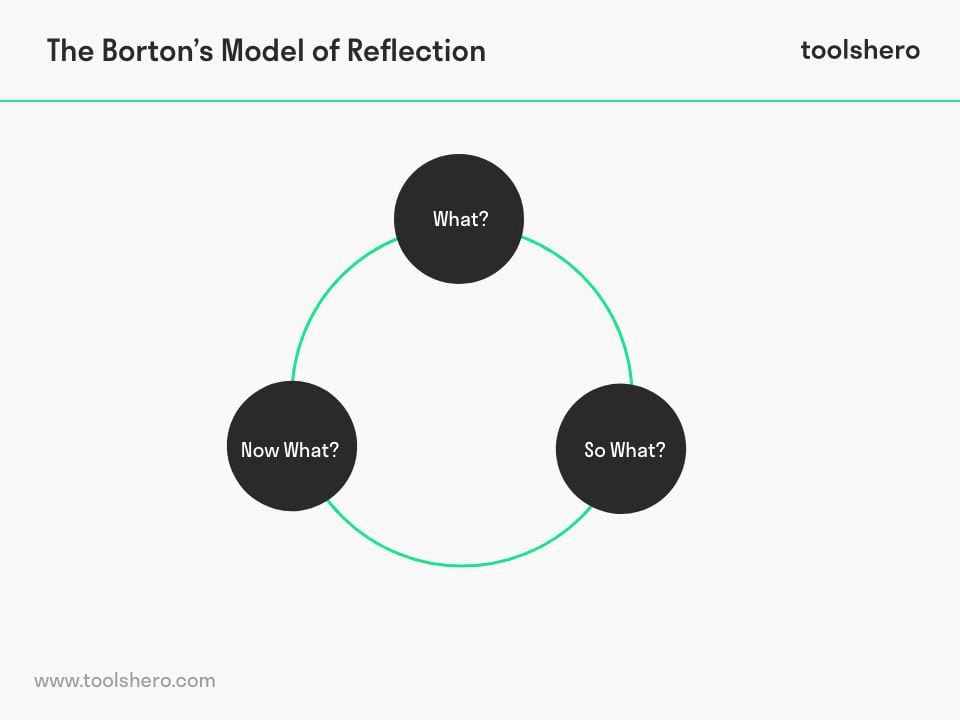Borton’s Model of Reflection

Borton’s model of reflection: this article explains Borton’s model of reflection in a practical way. After reading you will understand the basics of this powerful reflection method.
What is Borton’s model of reflection?
Borton’s model of reflection is a framework for reflection. It was developed by Terry Borton, an American school teacher in 1970. He published the method in the book ‘Reach, Touch and Teach’. In the book he calls it the ‘What, So What, Now What’-method of reflective education. It acts as a framework for reflective practice.
Borton’s framework is a straightforward model that is very easy to use and easy to implement in many situations. It allows the user to think about a situation without adding too much structure.
This makes the model a favorite among many students and healthcare professionals.
The framework includes only three questions:
- What?
- So what?
- Now what?
Borton himself states that it is a fluid process, in which there is no beginning and no end. One component cannot exclude the other component.
Why reflect?
Reflection in its simplest form is about careful thought. The kind of reflection that is really valuable to professionals and leaders is more extensive than careful thought. The most useful form of reflection is consciously considering and analyzing actions for the purpose of learning. This type of learning is also explained in the Kolb Reflective Cycle.
Reflection gives the brain a chance to pause in the midst of the chaos of observations and experiences. That helps to untangle and sort thoughts, allowing for multiple interpretations. It is then possible to extract value from this, which makes learning possible. Reflection is therefore crucial for leaders and professionals to grow and take steps in development.
To provide a framework for reflection in methods, practices and processes in order to build knowledge, several reflection models are available. Examples are the STARR method, the John Discroll Model of Reflection, the Gibbs Reflective Cycle and the Korthagen Reflection Model. These models help to make our learning more effective. Each model has a slightly different approach, but the phases are largely the same. Different people are attracted to different models depending on preferences and situations.
What?
In this first phase of Borton’s model of reflection, the question is: what? This part of the reflection process describes what exactly happened in relation to an event, task or experience. You briefly describe what happened and what you and others did.
Ask yourself the following questions to make it easy, but avoid including unnecessary details. Keep it concise.
- What happened?
- What have I seen?
- What have I done?
- What was my reaction to this?
- What did others involved do?
- What was I trying to achieve?
- What went well and what went badly during the experience?
So what?
In this phase of the reflection process, the question is: so what? This is an analysis of an event or experience. It is important during this phase that you begin to understand what actually happened in the situation you are describing. Why did things go the way they went?
Terry Borton argues that this stage is rational, intellectual, and cognitive. This is also where you apply theory to help understand what happened.
Some people use literature to consider different perspectives in order to interpret a situation. Keep the focus on yourself during this process.
Ask yourself the following questions:
- So what exactly did I feel in that moment?
- So what are my feelings now? Are they different from then?
- So what has changed since then?
- So what are the positive aspects of that experience?
- So what were the effects of what I did or didn’t do?
- So what have I noticed from the situation in practice?
Now what?
This third phase of Borton’s model of reflection revolves around the question: now what? This involves taking suggested actions after an event or experience. This is a process of thinking about what someone will do next and what the consequences of certain actions might be.
Many students and professionals find this part the most difficult because it almost always involves some degree of change. Change will require effort from a person.
These kinds of analyses sometimes reveal painful insights into their own behavior that need to be addressed. Also (inter)personal challenges with colleagues can come to the fore. Thinking about your own behavior (Metacognition) is never easy and requires experience.
Some questions that can help you with this are:
- What are the implications for me and others of what I have described earlier?
- What difference does it make if I choose to do nothing now?
- What is the most important thing I learned about my reflection?
- What kind of help do I need to see results from my reflections?
- What do I need to improve first?
Reflection in the workplace
Multiple studies on the effects of reflection on employee performance levels and growth have shown that reflection makes people more aware of their job as a whole. Employees who have applied reflection report that they have a better understanding of the tasks they perform and that they are better able to assess their importance.
An integral part of this process is recognizing mistakes and challenging thoughts you’ve had for a long time. Although this can be challenging, employees recognize its value for their growth and development as professionals.
If you are not used to reflecting, it can seem like a difficult and tedious task. Yet it is easier than you think to implement it in your own life. Especially once you’ve noticed the benefits of effective reflection.
While it is highly beneficial for employee productivity and overall understanding, few organizations offer their employees the opportunity to reflect. More often than not the message is: work harder and don’t stop to think, but keep moving forward.
Now It’s Your Turn
What do you think? Do you recognize the explanation about Borton’s model of reflection? What other reflection models are you familiar with? Or are you unfamiliar with reflection models? Do you think reflecting can produce insights you wouldn’t have otherwise?
Share your experience and knowledge in the comments box below.
More information
- Borton, T. (1969). Reach, touch, and teach. Saturday Rev.
- Wood, A., Apthorpe, R., & Borton, J. (2001). Evaluating international humanitarian action: reflections from practitioners. Zed Books.
- Skinner, M., & Mitchell, D. (2016). “What? So What? Now What?”: Applying Borton and Rolfe’s Models of Reflexive Practice in Healthcare Contexts. Health and Social Care Chaplaincy, 4(1), 10-19.
How to cite this article:
Janse, B. (2022). Borton’s Model of Reflection. Retrieved [insert date] from Toolshero: https://www.toolshero.com/personal-development/borton-model-of-reflection/
Published on: 09/09/2022 | Last update: 09/09/2022
Add a link to this page on your website:
<a href=”https://www.toolshero.com/personal-development/borton-model-of-reflection/”>Toolshero: Borton’s Model of Reflection</a>













